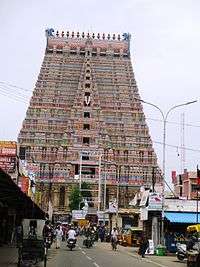Ranganathaswamy Temple, Srirangam
| Sri Ranganathaswamy Temple | |
|---|---|
|
Srirangam Temple Gopuram | |
 Sri Ranganathaswamy Temple Location in Tamil Nadu | |
| Name | |
| Proper name | Thiruvarangam |
| Geography | |
| Coordinates | 10°51′45″N 78°41′23″E / 10.86250°N 78.68972°ECoordinates: 10°51′45″N 78°41′23″E / 10.86250°N 78.68972°E |
| Country | India |
| State | Tamil Nadu |
| District | Tiruchirapalli |
| Location | Srirangam |
| Culture | |
| Primary deity | Aranganathar (Vishnu) |
| Consort | Aranganayagi (Lakshmi) |
| Poets |
Periyalvar Aandaal Kulasekara Alvar Thirumalisai Alvar Thondaradippodi Alvar Thiruppaan Alvar Thirumangai Alvar Poigai Alvar Bhoothathalvar Peyalvar Nammalvar |
| Appeared for | Ramanujar |
| Important festivals |
Vaikunda Ekadesi Uriyadi Jeeyarpuram |
| Architecture | |
| Architectural styles | Tamil architecture[1] |
| History and governance | |
| Website | http://www.srirangam.org/ |
| Part of a series on |
| Vaishnavism |
|---|
 |
|
Sampradayas |
|
Philosophers–acharyas |
|
Related traditions |
|
|
The Sri Ranganathaswamy Temple or Thiruvarangam (Tamil : திருவரங்கம்) is a Hindu temple dedicated to Ranganatha, a reclining form of Hindu deity, Vishnu located in Srirangam, Tiruchirapalli, Tamil Nadu, India . Constructed in the Tamil style of architecture,[1] this temple is glorified in the Thiviya Pirabandham, the early medieval Tamil literature canon of the Alvar saints from the 6th to 9th centuries AD and is counted among the 108 Divya Desams dedicated to Vishnu. The temple follows Thenkalai tradition of worship.[2]
It is one of the most illustrious Vaishnava temples in South India rich in legend and history. Its location, on an island in Cauvery river, has rendered it vulnerable to natural disasters as well as the rampaging of invading armies – Muslim and European – which repeatedly commandeered the site for military encampment.[3] The main entrance, known as the Rajagopuram (the royal temple tower), rises from the base area of around 13 cents (around 5720 sq ft) and goes up to 237 feet (72 m), moving up in eleven progressively smaller tiers. The annual 21-day festival conducted during the Tamil month of Margazhi (December–January) attracts 1 million visitors. Srirangam temple is often listed as the largest functioning Hindu temple in the world, the still larger Angkor Wat being the largest existing temple.[4][5] The temple occupies an area of 156 acres (631,000 m²) with a perimeter of 4,116m (10,710 feet) making it the largest temple in India and one of the largest religious complexes in the world.[6]
Legend
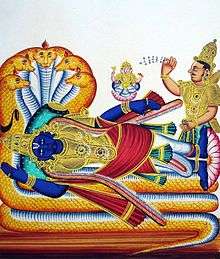
Sriranga Mahathmiyam is the compilation of religious accounts of the temple which detail the origins of its greatness.[7] According to it, Lord Rama, an Avatar of Vishnu, worshiped the idol for a long time, and when he returned victoriously from Sri Lanka after killing Ravana, he gave it to King Vibhishana as a token of appreciation for supporting him against Vibhishana's own brother, Ravana.[8] When Vibhishana was going via Trichy en route to Sri Lanka, the deity wanted to stay in Srirangam. Ranganatha, captivated by the devotion of a King called Dharma Varma, who was doing penance to have Lord Ranganatha to permanently stay Srirangam, stayed put, promising to cast his benign glance eternally on Lanka. Hence it is that the deity (in a reclining posture) faces South.[9][10]
As per another account, he was carrying it all the way to his kingdom of Sri Lanka and midway, to rest, he placed the image on the banks of Cauvery. After performing his routine pooja, he tried to lift the Vimana, but it could not be lifted. Mahavishnu appeared to him and said that he desired to stay as Ranganatha in the place, which went on to become Srirangam. Vishnu also desired to watch the Brahmotsavam at Tirucherai. The festivals of the temple are thus considered sacred.[11] It should be noted that the valmiki Ramayana mentions that vibishana received a gift from Sri rama while returning back to Lanka, but it does not specify the name of the gift. It is the parameshvara Samhita that identifies the gift with the idol of sri ranganatha
History
The temple is mentioned in Tamil literature in the Sangam era, including the epic Silapadikaram (book 11, lines 35–40):[12]
āyiram viritteḻu talaiyuṭai aruntiṟaṟ pāyaṟ paḷḷip palartoḻu tētta viritiraik kāviri viyaṉperu turuttit tiruvamar mārpaṉ kiṭanta vaṇṇamum
On a magnificent cot having a thousand heads spread out, worshipped and praised by many, in an islet surrounded by Kaveri with bellowing waves, is the lying posture of the one who has Lakshmi sitting in his chest
Silapadikaram (book 11, lines 35–40)
However, archaeological inscriptions are available only from the 10th century AD.[13] The inscriptions in the temple belong to the Chola, Pandya, Hoysala and Vijayanagar dynasties who successively swayed the destinies of the Tiruchirapalli district. They range in date between the 9th and 16th centuries and are registered by the ephigraphical society.[14]
The location where the Ranganathan idol was placed was later covered by an overgrowth of deep forests, due to disuse. After a very long time, a Chola king, chasing a parrot, accidentally found the idol. He then established the Ranganathaswamy temple as one of the largest temple complexes in the world.[15]
According to historians, most dynasties that ruled the South—Cholas, Pandiyas, Hoysalas, Nayaks, assisted with renovation and in the observance of the traditional customs. Even during periods of internal conflicts amongst these dynasties, utter importance was given to the safety and maintenance of these temples. It is said that a Chola king presented the temple with a golden serpent couch. Some historians identify this king with Rajamahendra Chola, supposedly the son of Rajendra Chola II. But it is of interest to note that he never figures in the latter's inscriptions, neither in the 4th year (that shows various members of the family going on rampage in different regions) nor in the 9th year (that shows only one member of the second generation).
During the period of invasion by Malik Kafur and his forces in 1310–1311, the idol of the deity was stolen and taken to Delhi. In a daring exploit, devotees of Srirangam ventured to Delhi and enthralled the emperor with their histrionics. Moved by their talent, the emperor was pleased to gift them the presiding deity of Srirangam, which was requested by the performers. Things took a drastic turn immediately. Surathani, his daughter, had fallen in love with the deity and followed him to Srirangam. She prostrated herself to the God in front of the sanctum sanctorum and is believed to have attained the heavenly abode immediately. Even today, a painting of "Surathani" (known as Thulukha Nachiyar in Tamil) can be seen in her shrine near the Arjuna Mandap adjacent to the sanctum sanctorum for whom, chappathis (wheat bread) are made daily.[16][17] The kalyana utsavam or wedding of Lord Ranganathar with Surathani is performed with great pomp every year.
Having assumed that the magical power of the deity had killed his daughter, there was a more severe second invasion to Srirangam in 1323 AD. The presiding deity was taken away before the Malik Kafur's troops reached Srirangam by a group led by the vaishnavite Acharaya (Guru), Pillai Lokacharyar, who died en route to Tirunelveli in Tamil Nadu. The Goddess Ranganayaki was taken in another separate procession. 13,000 Sri Vaishnavas, the people of Srirangam,[18] laid down their lives in the fierce battle to ensure that the institution was protected. In the end, Devadasis, the danseuse of Srirangam, seduced the army chief, to save the temple.
.jpg)
After nearly six decades, the presiding deity returned to Srirangam and the same Swami Vedanta Desika,[18] who had built a brick wall in front of the sanctum sanctorum, broke it open. The deity and the priestly wardens wandered southwards towards Madurai, then northeast towards Kerala, Mysore, Tirunarayanapuram, and finally in the hills of Tirumala Tirupati, where they remained until their reinstatement in 1371.[17]
The Orlov diamond of 189.62 carats (37.924 g), is a large diamond that is part of the collection of the Diamond Fund of the Moscow Kremlin. The origin of this resplendent relic – described as having the shape and proportions of half a hen's egg. This diamond and a similar gem served as the eyes of the deity in the temple. Legends hold that a French soldier who had deserted during the Carnatic wars in Srirangam.[19] Mention of the 2nd Carnatic war that was fought in Srirangam disguised himself as a Hindu convert and stole it in 1747.[20]erected in the 17th century
Architecture
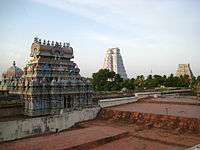
The temple is enclosed by 7 concentric walls (termed prakarams (outer courtyard) or mathil suvar) with a total length of 32,592 feet or over six miles. This temple has 21 gopurams (towers), 39 pavilions, fifty shrines, Ayiram kaal mandapam (a hall of 1000 pillars) and several small water bodies inside. The space within the outer two prakarams (outer courtyard) is occupied by several shops, restaurants and flower stalls.[21] Non-Hindus are allowed up to the second prakaram (outer courtyard) but not inside the gold topped sanctum sanctorum.
Shrines
The vimanam (shrine over the sanctum sanctorum), the Ranga vimana[22] is shaped like omkara (om symbol) and is plated with gold. Sri Ranganthar reclines on Adisesha, the coiled serpent. Images of Vibhishana, Brahma, Hanuman, Garuda, the symbols of Vishnu – conch and discuss are seen inside the sanctum.[23] Ranganayaki shrine is in the second precinct of the temple. The common reference to the goddess is padi thaanda pathni, meaning lady who doesn't cross the boundaries of ethics. Literally, the festival deity of Ranganayaki also does not come out of the shrine and it is Ranganthar who visits Ranganayaki. There are three images of Ranganayaki within the sanctum.
The complex houses shrines of dozens of forms of Vishnu including Chakkarathazhwar, Narasimha, Rama, Hayagreeva and Gopala Krishna. The Chakrathazhwar shrine is East facing on the South side of Akalanka precinct. The sanctum is approached through a Mukamandapa (six rows of pillars) built during the Cholas and a Mahamandapa with six rows of eight pillars built during the period of Vijayanagar Empire. There is a circumambulatory passage around the sanctum. The image of Chakrathazhwar is sculpted with Narasimha on the rear side and can be viewed from the passage around the sanctum.[24] There are separate shrines for Ranganayaki and the major saints in the Vaishnava tradition, including Ramanuja. The Venugopala shrine in the south-west corner of the fourth enclosure of the temple is the work of Chokkanatha Nayak. An inscription of 1674 specifies this Nayak king as the patron. The exterior of the vimana and attached mandap (hall) have finely worked pilasters with fluted shafts, double capitals and pendant lotus brackets. Sculptures are placed in the niches of three sides of the sanctuary walls; maidens enhance the walls in between. The elevation is punctuated with secondary set of pilasters that support shallow eaves at different levels to cap larger and smaller recesses. The sanctuary is crowned in the traditional fashion with a hemisphrical roof. The double-curved eaves of the entrance porch on the east side are concealed in a later columned hall.[25] Dhanvantari, a great physician of ancient India is considered to be an avatar of Vishnu – there is a separate shrine of Dhanvantari within the temple.[26]

Halls
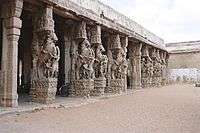
The Hall of 1000 pillars (actually 953) is a fine example of a planned theatre-like structure and opposite to it is the "Sesha Mandap". The 1000-pillared hall made of granite[27] was constructed in the Vijayanagara period (1336–1565) on the site of the old temple.[28] The pillars consists of sculptures of wildly rearing horses bearing riders on their backs and trampling with their hoofs upon the heads of rampant tigers, seem only natural and congruous among such weird surroundings.[29] The great hall is traversed by one wide aisle in the centre for the whole of its greater length, and intersected by transepts of like dimension running across at right angles. There still remain seven side aisles on each side, in which all the pillars are equally spaced out.[30] The Garuda Madapa (hall of the legendary bird deity of Vishnu, garuda) located on the south side of the third enclosure is another Nayak addition. Courtly portrait sculptures, reused from an earlier structure, are fixed to the piers lining the central aisle. A free-standing shrine inside the hall contains a large seated figure of garuda; the eagle-headed god faces north towards the principal sanctum.[25] The Kili mandapa (Hall of parrot) is located next to the Ranganatha shrine, in the first enclosure of the temple. Elephant balustrades skirt the access steps that ascend to a spacious open area. This is bounded by decorated piers with rearing animals and attached colonettes in the finest 17th-century manner. Four columns in the middle define a raised dais; their shafts are embellished with undulating stalks.[25] The most artistically interesting of the halls that the Nayaks added to the complex is the Sesha Mandap on the east side of the fourth enclosure. The hall is celebrated for the leaping animals carved on to the piers at its northern end.[25]
Gopurams

There are 21 gopurams (tower gateways), among which the towering 236-feet Rajagopuram (shrine of the main gateway) was the tallest temple tower in Asia until the rajagopuram of temple Murudeshwara was built by R. N. Shetty . The 73m high 13- tiered rajagopuram was built in 1987 by Ahobila Mutt and dominates the landscape for miles around, while the remaining 20 gopurams were built between the 14th and 17th centuries. The gopurams have pronounced projections in the middle of the long sides, generally with openings on each of the successive levels. The Vellai gopura (white tower) on the east side of the fourth enclosure has a steep pyramidal superstructure that reaches a height of almost 44m.[25]
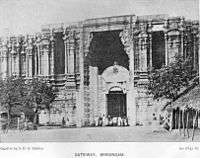
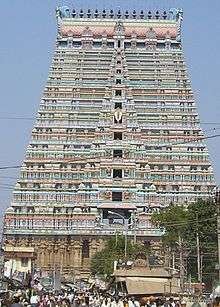
The structure of the rajagopuram remained incomplete at the base ('kalkaram', 17 meters high), for over 400 years. Started during the reign of Achyuta Deva Raya of Vijayanagar, the construction was given up after the king's death and apparently was not resumed owing to some political preoccupations or crisis. The Rajagopuram (the main gopuram) did not reach its current height of 73 m. until 1987, when the 44th Jeer of Ahobila Mutt initiated the process with the help of philanthropists and others. The whole structure was constructed in a span of eight years. The Rajagopuram was consecrated on 25 March 1987.[31] The length and breadth at the base of the Rajagopuram is 166 feet and 97 feet, while the length and breadth at the top is 98 feet and 32 feet. Befitting the gargantuan dimensions of the structure, every one of the 13 glistening copper 'kalasams' atop the tower weighs 135 kg and measures 3.12m (height) by 1.56m (diameter).
Administration and visit
| Temple Timings[32] | ||
|---|---|---|
| Type of Darshan | Ranganthar Shrine | Ranganayaki Shrine |
| Viswaroopa seva | 6:00-7:15 | 6:30-8:00 |
| Pooja (closed for devotees) | 7:15-9:00 | 8:00-8:45 |
| Darshan | 9:00-12:00 | 8:45-13:00 |
| Pooja (closed for devotees) | 12:00-13:15 | 13:00-15:00 |
| Darshan | 13:15-17:45 | 15:00-18:00 |
| Pooja (closed for devotees) | 17:45-18:45 | 18:00-18:45 |
| Darshan | 18:45-20:45 | 18:45-21:00 |
The temple is maintained and administered by the Hindu Religious and Endowment Board of the Government of Tamil Nadu. An Executive officer appointed by the Board manages the temple along with Sri Azhagiya Manavala Perumal Temple, Pundarikakshan Perumal Temple at Thiruvellarai, Sri Vadivazhagiya Nambi Perumal Temple and Mariamman Temple at Anbil. There are three trustees and a chairman for the board of trustees.[33][34] Annadhanam scheme, which provides free food to devotees, is implemented in the temple by the Board. Under the scheme, free food is offered to two hundred devotees every day in the temple and the expenditure is fully funded by the contributions from devotees.[33]
Festivals
The temple celebrates annual festival for almost 250 days a calendar year and Srirangam translates to cosmic stage or cosmic arena during the utsavam (festivals).[35]
Vaikunta Ekadeshi
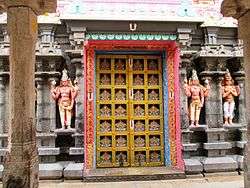
Pagal Pathu(10 day time) and Ra Pathu(10 day night time) festival is celebrated in the month of Margazhi(December–January) for twenty days. The first ten days are referred as Pagal-Pathu (10 day day time festival) and the second half as Ra Pathu(10 day night-time festival). The first day of Ra pathu is Vaikunta Ekadashi.[36] The eleventh day of each fortnight in Tamil calendar is called ekadesi and the holiest of all ekadesis as per vaishnavite tradition is the Vaikunta Ekadashi. Nammazhwar, one of the 12 azhwars, is believed to have ascended to vaikuntam(the heavenly abode of Vishnu) on this day. The devotion of the 9th-century poet, Nammazhwar, and his perceived ascent to heaven are enacted annually. During the festival, through song and dance, this place is affirmed to be Bhoologa Vaikunta(heaven on earth).[6] Araiyar Sevai is a divine colloquim of araiyars, who recite and enact Nalayara Divya Prabanda, the 4000 verses of azhwars (Vaishnavite poets of the 7th–10th century).[37][38] Araiyars are born to Araiyar tradition most prevalent in Sri Vaishnava families in Srirangam, Alwar Thirunagari and Srivilliputhur.[37] The tradition of Araiyar Sevai was started by Nathamuni, a 10th-century Vaishnavite who compiled the works of azhwars.[38] It is believed as per Hindu mythology that 33 crores of gods come down to witness the event.[39][40] The festival deity is brought to the 1000-pillared hall on the morning of Vaikunta Ekadashi through the Paramapada Vasal (gate to paradise).[41] Lakhs of pilgrims rush to enter it after the gate is opened and the deity passes through it as it is believed that one who enters here will reach vaikuntam (heaven) after death. The gate is open only during the ten days of Pagal Pathu (10 day day-time festival). On the last day of the festival, the poet Nammazhwar is said to be given salvation. The performance is enacted by priests and images in the temple depicts Nammazhwar as reaching heaven and getting liberation from the cycle of life and death. At that point, a member from the crowd of devotees, who are witnessing this passion play, goes up to the centre stage and requests Vishnu to return Nammazhwar to humanity, so that his words and form in the temple will continue to inspire and save the devotees. Following this performance of the salvation of Nammazhwar, the cantors are taken in procession round the temple.[42]
Jyestabisheka
The annual gold ornament cleaning festival is called Jyestabisheka (first of anointing) and is celebrated during the Tamil month of aani (June–July). The idols of all deities are abluted with water brought in large vessels of gold and silver.
Brahmotsavam
Brahmotsavam (Prime festival) is held during the Tamil month of Panguni (March–April). The preliminaries like ankurapuranam, rakshabandanam, bherira thanam, dhrajarohanam and the sacrificial offerings in the yagasala are gone through as usual. The processions go round the Chitrai street in the evenings. On the second day, the deity is taken to a garden inside the temple. The deity is taken in a palanquin through the river Cauvery to a village on the opposite shore namely Jiyarpuram on the third day.[43]
Other Festivals
The annual temple chariot festival, called Rathothsavam is celebrated during the Tamil month of thai (January–February) and the processional deity, utsavar is taken round the temple in the temple car. Chitra Poornima is a festival based on the mythological incident of Gaj-graha (elephant crocodile). The elephant suffered in the jaws of crocodile and god rescued the elephant. Vasanthothsavam is celebrated during the Tamil month of vaikasi (May–June) which according to inscriptions is celebrated from 1444 AD.
Composers

Ranganathaswamy temple is the only one out of the 108 temples that was sung in praise by all the Azhwars(Divine saints of Tamil Bhakthi movement), having a total of 247 pasurams (divine hymns) against its name. Acharyas (guru) of all schools of thought – Advaita, Vishistadvaita and Dvaita recognise the immense significance the temple, regardless of their affiliation.
Nalayira Divya Prabhandam is a collection of 4000 hymns sung by twelve azhwars saints spread over 300 years (from the late 6th to 9th century AD) and collected by Nathamuni (910–990 AD).[44] Divya Desams refer to 108 Vishnu temples that are mentioned in Nalayira Divya Prabandham. 105 of these are located in India, 1 in Nepal, while 2 are located outside of the Earthly realms. Divya in Tamil language indicates premium and Desam indicates place or temple. Periyalvar begins the decad on Srirangam with two puranic stories according to which Krishna restored to life the son of his guru Santipini and the children of a brahmin.[45] Thondaradippodi Alvar and Thiruppaana Alvar have sung exclusively on Ranganatha. Andal attained Sri Ranganatha on completion of her Thiruppavai (a composition of 30 verses) in Srirangam. In total there are 247 hymns of the 4000 Pasurams dedicated to Ranganthar deity of this temple. Except Madhurakavi Alvar, all the other eleven azhwars have created Mangalasasanam (praise) about the Ranganathar in Srirangam. Out of 247, 35 are by Periyalvar, 10 by Aandaal, 31 by Kulasekara Alvar, 14 by Thirumalisai Alvar, 55 by Thondaradippodi Alvar, 10 by Thiruppaan Alvar, 73 by Thirumangai Alvar, one by Poigai Alvar,4 by Bhoothathalvar, two by Peyalvar and twelve by Nammalvar.
Kambar is a 12th-century Tamil poet who composed Kamba Ramayanam, a work inspired from the epic, Valmiki Ramayana. He is believed to have come to the temple to get the approval of his work from scholars. The Jain scholar Tirunarungundam honoured the work and it resulted in Tamil and Sanskrit scholars approving the work.[46] The open hall where he recited his verse lies close to the Ranganayaki shrine within the temple.
Some of the religious works like Sri Bhashyam by Ramanuja,[47] Sriranga Gadhyam by Vaikunta Gadhyam and Saranagadhi Gadhyam (Gadhyathrayam) by Ramanuja,[48] Sri Renganathashtakam by Adi Shankaracharya,[49] Paduka Sahasram by Swami Vedanta Desika,[50] Rengaraja Stavam and Gunaratnakosham by Sri Parasar bhattar,[51] Rengaraja Sthothram by Kurathazhwar, Bhagavaddhyana Sopnam and Abheethi Stavam by Swami Vedanta Desika[52] are works that were exclusively composed in praise of Srirangam temple.
Religious significance
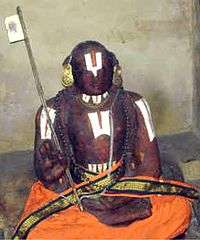
The term Kovil is generally used in Tamil to signify any temple, for many Vaishnavas the term Kovil exclusively refers to this temple, indicating its extreme importance for them (for saivas and all other Tamil people the term kovil refers to Thillai Natarajar Golden Shrine (Chidambaram Temple)). The presiding deity Ranganathar is praised in many names by his devotees, including Nam Perumal (our god in Tamil), Azhagiya Manavaalan (beautiful groom in Tamil).
The temple is considered in the Alwar traditions as one of the eight Sywayambu Kshetras of Vishnu where presiding deity is believed to have manifested on its own. Seven other temples in the line are Bhu Varaha Swamy temple, Tirumala Venkateswara Temple, and Vanamamalai Perumal Temple in South India and Saligrama, Naimisaranya, Pushkar and Badrinath Temple in North India.[53]
Ramanuja was a theologian, philosopher, and scriptural exegete. He is seen by Śrīvaiṣṇavas as the third and most important teacher (ācārya) of their tradition (after Nathamuni and Yamunacharya), and by Hindus in general as the leading expounder of Viśiṣṭādvaita, one of the classical interpretations of the dominant Vedanta school of Hindu philosophy. Ramanuja renounced his family life and went to Srirangam to occupy the pontificate – Srirangam became the stronghold of him and his disciples.[54] The doctrine of Vishishtadvaita philosophy, Sri Bhashyam was written and later compiled by him over a period of time.[55] During his stay in Srirangam, he is said of have written "Gadhya Thrayam", which is recited in the temple during the ninth day (Panguni Uttaram) of the festival of Adi brahmotsavam. The temple is a center for the Vishishtadvaita school where Sanskrit Vedas and Tamil works are preached and taught with great reverence. He attained divinity in Srirangam. His Thaan-ana Thirumeni (the symbolic body) is preserved and offered prayers even today after eight centuries. The disciples of Ramanuja got his permission to install three metallic images, one each at Sriperumpudur, Melkote and the third, at Srirangam.[56] The shrine is found in the fourth prakaram (outer courtyard) of the temple and the idol is preserved in the temple by applying saffron and camphor every six months in a ritualistic style. He is found seated in the Padmasana (yogic sitting posture), depicting the Gnyana-Mudrai (symbol of knowledge) with his right palm. "Kovil Ozhugu" is a codification of all temple practices, religious and administrative, shaped and institutionalised by Sri Ramanuja after receiving the due rights from Sri Thiruvarangathamudanar. A stone inscription to this effect is installed in the Arya patal vasal (main gate before the first precinct).[57]
Pancharanga Kshetrams (also called Pancharangams, meaning the "five Rangams or Ranganathas") is a group of five sacred Hindu temples, dedicated to Ranganatha, a form of the god Vishnu, on the banks of the Kaveri River. The five Pancharanga Kshetrams in the order of their successive locations, on the banks of the Kaveri River are: The Srirangapatnam called the Adi Ranga, the first temple on the banks of the Kaveri River from the upstream side; the Sri Ranganathaswamy Temple at Srirangam known as Adya Ranga (the last temple), Appalarangam or Koviladi at Tiurppernagar in Tamil Nadu, Parimala Ranganatha Perumal Temple or Mayuram at Indalur, Mayiladuthurai and Vatarangam at Sirkazhi. The Sarangapani temple at Kumbakonam is mentioned in place of Vatarangam in some references.[58][59]
Notes
- 1 2 Urwick 2007, p. 58.
- ↑ http://www.srirangam.org/
- ↑ Spencer 1978, p. 3.
- ↑ Vater 2010, p. 40.
- ↑ Jones 2004, p. 4.
- 1 2 Mittal & Thursby 2005, p. 456.
- ↑ Thames 2002.
- ↑ Khanna 2003, p. 197.
- ↑ Gray & Hancock 2003, p. 134.
- ↑ Bhoothalingam 2011, pp. 53-58.
- ↑ M., Rajagopalan (1993). 15 Vaishnava Temples of Tamil Nadu. Chennai, India: Govindaswamy Printers. pp. 66–75.
- ↑ Silappadikaram.
- ↑ Sircar 1979, p. 64.
- ↑ Ayyar 1991.
- ↑ Sajnani 2001, p. 312.
- ↑ Sundararajan & Mukerji 2003, p. 434.
- 1 2 Hopkins 2002, p. 69.
- 1 2 Ramaswamy 2007, pp. 301–302.
- ↑ Jaques 2007, p. 928.
- ↑ Erlich & Hausel 2002, p. 66.
- ↑ Malcolm 1839, p. 69.
- ↑ Thursby 1903, p. 61.
- ↑ Dallapiccola 2007, p. 67.
- ↑ Madhavan, Chithra (2007). Vishnu Temples of South India Volume 1 (Tamil Nadu). Chithra Madhavan. pp. 85–86. ISBN 978-81-908445-0-5.
- 1 2 3 4 5 Mitchell 1995, p. 109.
- ↑ Sircar 1971, p. 162.
- ↑ Malcolm 1839, p. 70.
- ↑ Doniger 1999, p. 1026.
- ↑ Klein 1895, p. 89.
- ↑ Fergusson 1876, p. 352.
- ↑ Chand 1987, p. 36.
- ↑ Temple timings.
- 1 2 J. 2013, p. 3-5.
- ↑ Srirangam temple administration.
- ↑ Mittal & Thursby 2005, p. 472.
- ↑ Madras District Gazetteers 1907, pp. 319-322.
- 1 2 Narayanan 1994, pp. 43–44.
- 1 2 Cutler 1987, p. 187.
- ↑ Murdoch 1904, p. 13.
- ↑ Sastri 1988, pp. 6-7.
- ↑ Cole 1882, p. cxx.
- ↑ Mittal & Thursby 2005, p. 474.
- ↑ Rao 1967, p. 149.
- ↑ Mukherjee 1998, p. 248.
- ↑ T. 2002, p. 53.
- ↑ Kanuga 1993, p. 15.
- ↑ Theosophist Magazine April 1931 – June 1931 .Annie Wood Besant
- ↑ Life, thought, and culture in India, c. AD 300–1000 .Snip View. K. Satchidananda Murty, S. Sankaranarayanan, Project of History Indian Science
- ↑ The Journal of the Music Academy, Madras, Volume 61 Proceedings of the Madras Music conferences, 1930 Snippet View.Music Academy (Madras, India)
- ↑ Lal 2001, p. 4525.
- ↑ Kumar 1997, p. 77.
- ↑ V.K. 2007, p. 77.
- ↑ S., Prabhu (10 May 2012). "Symbolising religious unity". The Hindu. Retrieved 13 October 2014.
- ↑ Narasimhachary 2004, p. 23.
- ↑ Dasgupta 1991, p. 114.
- ↑ Narasimhachary 2004, p. 37.
- ↑ The life of Râmânujâchârya: the exponent of the Viśistâdvaita philosophy p. 208. Alkandavilli Govindāchārya
- ↑ Kapoor 2002.
- ↑ Dalal 2011, p. 339.
References
- "Srirangam temple administration". Sri Ranganathar Swamy Temple Administration. Retrieved 2013-10-10.
- "Srirangam temple pooja schedule". Sri Ranganathar Swamy Temple Administration. Retrieved 2013-10-10.
- "Madras District Gazetteers: Tiruchirappalli". Madras (India : State): Superintendent, Government Press. 1907: 319–322.
- J., Sulochana Gandhi; R., Soundarajan (January 2013). "Lord Sri Ranganatha Temple — a study" (PDF). Monthly Multidisciplinary Research Journal. 2 (7): 2–5. ISSN 2231-5063. Retrieved 2013-09-09.
- "Silappadikaram". Project Madurai. 2000.
- Ayyar, P. V. Jagadisa (1991) [1935]. South Indian shrines: illustrated. New Delhi: Asian Educational Services. ISBN 81-206-0151-3.
- Cole, Henry Hardy (1882). Report of the Curator of Ancient Monuments in India for the year 1881–1882. Government Central Branch Press. p. cxx.
- Bhoothalingam, Mathuram (2011). S. Manjula, ed. Temples of India - Myths and legends. Publications Division, Ministry of Information and Broadcasting, Government of India. ISBN 978-81-230-1661-0.
- Chand, Attar (1987). The great humanist Ramaswami Venkataraman. Delhi: Gyan Books. ISBN 81-212-0106-3.
- Cutler, Norman (1987). Songs of experience: the poetics of Tamil devotion. USA: Norman J. Cutler. ISBN 0-253-35334-3.
- Dallapiccola, Anna Libera (2007). Indian art in detail, Part 26. China: The British Museum Press. ISBN 978-0-674-02691-9.
- Dalal, Roshen (2011). Hinduism: An Alphabetical Guide. Penguin Books India. p. 339. ISBN 978-0-14-341421-6.
- Dasgupta, Surendranath (1991). A history of Indian philosophy. Motilal Banarsidass Publisher. p. 388. ISBN 9788120804081.
- Doniger, Wendy (1999). Merriam-Webster's encyclopedia of world religions. Merriam-Webster, Inc. ISBN 9780877790440.
- Encyclopaedia Britannica (India) (2000). Students' Britannica India, Volumes 1–5. Hong Kong: Encyclopaedia Britannica Inc. ISBN 0-85229-760-2.
- Erlich, Edward; Hausel, W. Dan (2002). Diamond deposits: origin, exploration, and history of discovery. USA: Society of Mining, Metallurgy, and Exploration, Inc.(SME). ISBN 0-87335-213-0.
- Fergusson, James (1876). A history of architecture in all countries. London: Harvard University Library.
- Gray, Martin; Hancock, Graham (2003). Sacred earth: places of peace and power. New York: Sterling Publishing Co. Inc. ISBN 978-1-4027-4737-3.
- Hopkins, Steven Paul (2002). Singing the body of God: the hymns of Vedāntadeśika in their South Indian. New York: Oxford University Press. ISBN 0-19-512735-8.
- Jaques, Tony (2007). Dictionary of battles and sieges: a guide to 8,500 battles from Antiquity through the Twenty-first Century, Volume 3. USA: Greenwood Publishing Group. ISBN 9780313335396.
- Jones, Victoria (2004). Wonders of the World Dot-to-Dot. New York: Sterling Publishing Co., Inc. ISBN 1-4027-1028-3.
- Kanuga, Prof G.B. (1993). Immortal love of Rama. New Delhi: Lancer Publishers Pvt. Ltd. ISBN 1-897829-50-7.
- Kapoor, Subodh (2002). The Indian Encyclopaedia: Timi-Vedic Age. Cosmo Publications. ISBN 978-81-7755-280-5. Retrieved 13 December 2012.
- Khanna, Amar Nath (2003). Pilgrim shrines of India: mythology, archaeology, history and art (Hindu, Jain, Buddhist, Sikh, Jewish, Christian & Sufi). Aryan Books International.
- Klein, Augusta (1895). Among the gods: scenes of India : with legends by the way. Edinburgh & London: William Blackwood and Sons.
- Kumar, P. Pratap (1997). The goddess Lakṣmī: the divine consort in South Indian Vaiṣṇava tradition. USA: The American Academy of Religions. ISBN 0-7885-0198-4.
- Lal, Mohan (2001). The Encyclopaedia Of Indian Literature Volume Five (Sasay To Zorgot). New Delhi: Sahitya Akademi. ISBN 81-260-1221-8.
- Malcolm, Howard (1839). Travels in South-eastern Asia, Embracing Hindustan, Malaya, Siam, and China: With Notices of Numerous Missionary Stations, and a Full Account of the Burman Empire; with Dissertations, Tables, Etc, Volume 2. Gould, Kendall, and Lincoln.
- Mitchell, George (1995). Architecture and art of southern India: Vijayanagara and Successor states, Volume 1, Issue 6. Cambridge: Cambridge University Press. ISBN 0-521-44110-2.
- Mittal, Sushil; Thursby, G. R. (2005). The Hindu World. New York: Routelge. ISBN 0-203-67414-6.
- Mukherjee, Sujit (1998). A Dictionary of Indian Literature: Beginnings-1850. Orient Blackswan. ISBN 9788125014539.
- Murdoch, John (1904). Hindu and Muhammadan festivals. Asian Educational Services. ISBN 9788120607088.
- Narasimhachary, Madabhushini (2004). Sri Ramanuja. New Delhi: Sahitya Akademi. ISBN 81-260-1833-X.
- Narayanan, Vasudha (1994). The vernacular Veda: revelation, recite book, and ritual. Columbia: University of South California. ISBN 0-87249-965-0.
- Ramaswamy, Vijaya (2007). Historical dictionary of the Tamils. United States: Scarecrow Press, INC. ISBN 978-0-470-82958-5.
- Rao, V. N. Hari (1967). The Srīrangam temple: art and architecture. Sri Venkateswara University.
- Sajnani, Dr. Manohar (2001). Encyclopedia of tourism resources in India, Volume 2. Delhi: Kalpaz Publications. ISBN 81-7835-014-9.
- Sastri, Pandit Natesa (1988). Hindu Feasts, Fasts and Ceremonies. Asian Educational Services. ISBN 9788120604025.
- Sircar, D.C. (1979). Some Epigraphical Records of the Medieval Period from Eastern India. Delhi: Shakti Malik. ISBN 9788170170969.
- Sircar, Dineschandra (1971). Studies in the religious life of ancient and medieval India. India: Sundarlal Jain. ISBN 81-208-2790-2.
- Spencer, George W. (1978). Religion and the legitimation of power in South Asia. Netherlands: E.J. Brill, Leiden. ISBN 90-04-05674-2.
- Sundararajan, K.R.; Mukerji, Bithika (2003). Hindu spirituality: Postclassical and modern. New Delhi: Motilal Banarsidass Publishers. ISBN 81-208-1937-3.
- T., Padmaja (2002). Temples of Krsna in South India. New Delhi: Abhinav Publications. ISBN 81-7017-398-1.
- Thames (2002). "Srirangam (Tiruchirapalli district, Tamil Nadu)". Dictionary of Hindu Lore and Legend, Thames & Hudson. London, United Kingdom: Thames & Hudson – via Credo. (subscription required (help)).
- Thursby, G. R. (1903). Annual report of the Archaeological Department, Southern Circle, Madras. Madras: Government Press.
- Urwick, William (2007). Indian pictures, drawn with pen and pencil. Google(digitised) –.
- V.K., Subramanian (2007). 101 Mystics of India. New Delhi: Abhinav Publications. ISBN 81-7017-471-6.
- Vater, Tom (2010). Moon Spotlight Angkor Wat. USA: Perseus Books Group. ISBN 9781598805611.
External links
| Wikimedia Commons has media related to Sri Ranganathaswamy Temple (Srirangam). |
